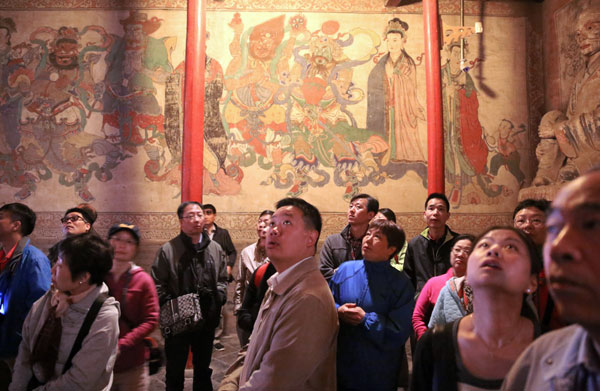Culture, tourism seen as key to developing new Silk Road
 0 Comment(s)
0 Comment(s) Print
Print E-mail China Daily, May 27, 2014
E-mail China Daily, May 27, 2014
|
|
|
Tourists visit the Giant Buddha Temple on Sunday in Zhangye, Gansu province. The temple was built in 1098 and is located along the ancient Silk Road. In 2013, it received more than 1,100 Central Asian and Turkish visitors. Experts said cultural exchanges between China and Central Asia will be a foundation for the Silk Road economic belt proposed by President Xi Jinping last year. [Photo by Jiang Dong/China Daily] |
Editor's note: During his visit to Kazakhstan in September, President Xi Jinping proposed that China and Central Asia join hands to build a Silk Road economic belt to boost cooperation. The idea has been widely echoed in Central Asian countries, becoming an encouraging blueprint for Chinese areas along the Silk Road that has linked Asia and Europe for more than 2,000 years. In the next three weeks, China Daily reporters will travel along the belt in China, Kazakhstan, Uzbekistan and Turkey. They will show the progress and expectations of the countries, businesses and peoples on the route.
Tourism and cultural exchanges will be useful tools in building the new foundation for the Silk Road economic belt, officials and scholars from China's northwestern provinces said.
Zhang Shengzhen, secretary-general of the Gansu provincial government, said the modern Silk Road will promote commodity exchanges as well as cultural exchanges.
"Launching more cultural exchanges and tourism activities between China, Central Asia and Turkey will help those trade partners further understand the meaning of the Silk Road economic belt, and realize that China will not be the only winner on the route to the West," Zhang said.
The modern Silk Road is more than just a channel for China to import resources such as crude oil, natural gas or farm products from Central Asia, Zhang said.
"People from Central Asia could visit China's western provinces first to see what the ancient Silk Road did to benefit their countries in the past."
China's willingness to explore cultural differences and similarities is seen as one of the concrete achievements of President Xi Jinping's four-nation Central Asian tour last year.
Chen Kegong, Party chief of Zhangye, a city along the ancient Silk Road in Gansu province, said the city has been dedicated to promoting cultural exchanges with people from Central Asia.
The city's Giant Buddha Temple, established in 1098 about 600 kilometers west of Gansu's provincial capital, Lanzhou, received more than 1,100 Central Asian and Turkish visitors in 2013. The number has steadily increased, Chen said.







